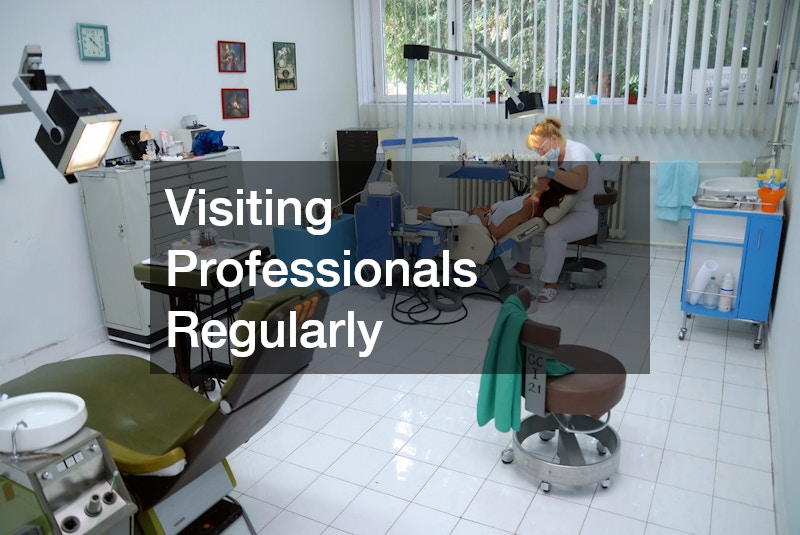
In today’s fast-paced world, maintaining optimal health is more important than ever. One crucial aspect of overall well-being is oral health, which often gets overlooked. Regular visits to health professionals can ensure that not only your teeth but your entire body stays healthy as well. In fact, research shows a direct connection between oral health and various systemic diseases. When we talk about health, it’s essential to understand the implications of neglecting dental care on our physical and emotional well-being, while recognizing the importance of comprehensive family care. Taking proactive steps in daily habits can significantly reduce risks and improve long-term outcomes.
Oral health impacts nutrition, self-esteem, and even heart health. A well-maintained smile can boost confidence and help in social interactions. Therefore, it is vital to educate ourselves about various dental practices and treatments available today, from traditional corrective methods to innovative solutions, as well as advancements in treatments that enhance smiles.
This article aims to provide insights into effective strategies for maintaining oral health, focusing on the importance of regular dental visits and family care. We will explore different treatments and options available for correcting alignment issues. Furthermore, we will underline the importance of collaboration among healthcare professionals to ensure comprehensive care that benefits overall health and wellness.

Visiting Professionals Regularly
Regular visits to a dentist office are crucial for maintaining optimal oral health. These professionals conduct thorough check-ups and cleanings that help prevent cavities, gum disease, and other dental issues. By visiting regularly, you set a strong foundation for not only your dental wellness but your overall health as well.
Dentists can catch potential problems early and provide solutions that might save you from more complex and costly treatments down the line. They play a pivotal role in educating patients about proper dental hygiene, dietary choices, and how to effectively care for their teeth at home. The emphasis is not just on the mouth but recognizes the intricate connections between oral health and systemic health.
Moreover, establishing a routine of family dental care not only sets a good example for younger family members but also creates a supportive environment for discussing health. When families attend dental appointments together, it can reduce anxiety and foster a positive attitude towards oral health. Regular visits ensure that everyone remains accountable for their health, promoting a holistic approach to well-being.
Building Strong Family Health Foundations
Building strong foundations for family dental care begins with educating family members on the importance of oral hygiene. Simple practices like regular brushing and flossing can prevent dental issues in the long run. When families prioritize dental health, it creates a culture of wellness that extends beyond the dental chair.
Engaging children in conversations about the importance of healthy teeth can create responsible habits that last a lifetime. Activities like visiting the dentist office for fun events or learning about how cavities form can make oral health interesting for younger family members. This proactive approach to dental care fosters a strong commitment to personal health.
Additionally, understanding the role of professional evaluations becomes paramount. Comprehensive family dental care may include orthodontic evaluations at an early age to determine whether treatments such as braces or clear aligners are necessary. By taking these steps, families can build a foundation for healthy smiles and ensure that every member receives the dental attention they need.
Correcting Alignment for Overall Wellness
Orthodontic treatment extends beyond improving aesthetic appeal; it can also enhance overall wellness. Misaligned teeth can lead to issues such as jaw pain, headaches, and difficulty chewing, all of which affect a person’s quality of life. Through options like braces treatment or clear aligners, individuals can achieve better alignment and improved functionality.
Exploring orthodontic treatment options with a qualified orthodontist is essential. These professionals assess the structural dynamics of the mouth and provide tailored solutions that suit individual needs. Whether opting for traditional braces or modern clear aligners, the goal remains the same: to achieve a healthy, well-aligned smile that contributes to better oral health.
Moreover, by addressing alignment issues, one may also reduce the risk of developing periodontal diseases. When teeth are properly aligned, they are easier to clean, leading to better oral hygiene. This connection demonstrates the importance of comprehensive care in achieving both functional and aesthetic objectives.

Exploring Discreet Solutions for Alignment
Clear aligners represent a popular and discreet solution for individuals seeking orthodontic treatment. Unlike traditional braces, these invisible trays provide a less noticeable way for patients to correct their smiles. This is especially appealing for adults and teenagers who may feel self-conscious about wearing braces.
The clear aligners are custom-made to fit snugly over the teeth, gradually shifting them into the desired position. Regular visits to the dentist office ensure that progress is monitored and adjustments are made as needed for optimal results. Patients often appreciate the convenience of being able to remove aligners during meals and for oral hygiene, making daily routines easier.
Additionally, clear aligners can be related to better patient compliance since they typically have less discomfort compared to traditional braces. As patients engage in their orthodontic treatment, pursuing their goals becomes more enjoyable and achievable. This creates a positive cycle of investment in their health and wellness.
Understanding Traditional Corrective Options
Traditional braces treatment remains a reliable method for correcting dental misalignment. While they may be more visible than clear aligners, braces offer precise control over tooth movement. For some individuals, this control can make braces the preferred choice for achieving optimal oral health.
The process of receiving braces begins with a comprehensive evaluation by an orthodontist. Based on this evaluation, a personalized treatment plan is developed, addressing each patient’s unique dental needs. Patients often find comfort in understanding the timeline and expected outcomes involved with braces, which helps manage expectations.
Traditional braces also have the advantage of addressing complex alignment issues, making them suitable for a wide range of cases. Despite the potential discomfort of wearing braces, the end result—a beautifully aligned smile—often outweighs the temporary challenges. In this way, braces treatment reinforces the idea that commitment to dental care yields lasting benefits for individual health.
Restoring Function and Appearance
Dental bridges serve as an essential solution for restoring functionality and aesthetics after tooth loss. These fixed prosthetic devices can bridge the gap created by missing teeth, enabling individuals to regain their ability to chew and speak confidently. Moreover, a well-constructed dental bridge can enhance an individual’s appearance, allowing them to smile without reservations.
The process of placing a dental bridge begins with an assessment of the patient’s dental structure. Depending on the individual’s needs, bridges can be anchored to surrounding teeth or secured through dental implants. Dental implants provide a stable foundation, ensuring long-term retention and strength, which is often crucial for maintaining jaw integrity.
Additionally, dental professionals often collaborate with cosmetic dentistry experts to ensure that the color, shape, and overall aesthetics of the dental bridge match the patient’s natural teeth. This seamless integration is fundamental for creating a natural, pleasing appearance. The result is a restoration that not only revitalizes functionality but also enhances confidence and quality of life.

Enhancing Smiles with Specialized Care
Cosmetic dentistry plays a vital role in enhancing smiles and addressing aesthetic concerns. From teeth whitening to veneers, these specialized treatments cater to individuals seeking improvements in the appearance of their teeth. By addressing cosmetic issues, patients often experience increased confidence and a renewed sense of pride in their smiles.
Working with a qualified cosmetic dentist allows individuals to explore various options for smile enhancement. Personalized consultations help patients understand the benefits and limitations of different procedures, ensuring they make informed decisions. Whether it involves minor adjustments or full smile makeovers, the focus remains on achieving beautiful, natural-looking results.
Moreover, integrating cosmetic procedures with general dental care creates a comprehensive approach to oral health. Regular visits to a dentist office, combined with specialized care, ensure that patients not only look good but also maintain optimal dental health. This holistic perspective reinforces the connection between aesthetic improvements and well-being.
Permanent Solutions for Missing Teeth
Dental implants represent one of the most effective permanent solutions for missing teeth. These advanced restorations mimic the function of natural teeth by integrating with the jawbone, providing stability and durability. Implants are often considered the gold standard for tooth replacement due to their long-term success and natural appearance.
Receiving dental implants involves a series of steps, beginning with a thorough examination and consultation to determine the patient’s suitability. After the initial assessment, a surgical procedure is performed to insert the implant into the jawbone. Over time, the implant fuses with the bone in a process called osseointegration, creating a sturdy foundation for an artificial tooth.
Patients often appreciate dental implants not only for their functionality but also for the boost in self-esteem they provide. With proper care, dental implants can last a lifetime, making them a cost-effective investment in one’s overall health. This permanence underscores the importance of addressing dental issues promptly, ensuring that missing teeth do not hinder a vibrant lifestyle.
Utilizing Medical Centers for Comprehensive Care
Healthcare facilities play an integral role in providing comprehensive care to both general and specialized health needs. Utilizing medical centers allows patients to receive coordinated treatment that encompasses dental and overall health. This integrated approach ensures that all components of a patient’s health are addressed, leading to improved outcomes.
In addition, many healthcare facilities are starting to emphasize the connection between oral health and systemic diseases. Collaborations among various healthcare professionals, including dentists and other specialists, are essential for creating an informed treatment plan. Regular health evaluations, along with dental check-ups, can reveal underlying issues that affect both oral and general health.
Such coordinated care highlights the importance of a multidisciplinary approach to health and showcases the necessity of visiting a healthcare facility for comprehensive assessments. By prioritizing regular evaluations, patients empower themselves to make informed decisions regarding their well-being. This holistic view ensures that individuals can take preventative measures that enhance their quality of life.

Collaborating with Heart Specialists
Collaboration with heart physicians exemplifies the interconnectedness of oral and systemic health. Research has shown that poor oral hygiene can contribute to cardiovascular diseases, emphasizing the need for comprehensive evaluations. When patients prioritize both dental and heart health, they cultivate holistic wellness that addresses multiple dimensions of health.
Regular check-ups with heart specialists can give patients crucial insights into how their oral health impacts overall well-being. Patients with existing heart conditions are often advised to maintain strict oral hygiene routines to prevent complications. This holistic understanding underscores how vital it is to work collaboratively with various healthcare providers.
Fostering collaboration among healthcare professionals is essential for providing complete and effective care. Such interdisciplinary approaches not only facilitate better health outcomes but also enhance patients’ understanding of the intricate connections between various health aspects. By prioritizing collaboration, patients take significant strides toward optimal health, integrating both dental and cardiovascular wellness.
Maintaining optimal health through dental care is a multifaceted journey that starts with regular visits to the dentist office. Investing in family dental care establishes strong foundations for lifelong oral health. This article has explored various treatment options—from traditional braces treatment and orthodontic treatment to permanent solutions like dental implants and cosmetic dentistry—that enhance smiles and improve well-being.
The importance of understanding each treatment’s role in enhancing overall health cannot be overstated. Whether opting for clear aligners or choosing to undergo extensive procedures like dental bridges, individuals empower themselves to make informed decisions that positively impact their lives. Additionally, collaborating with various healthcare professionals, including heart physicians, ensures a holistic approach to health that benefits all facets of life.
Ultimately, a commitment to oral health not only leads to better hygiene and aesthetics but also contributes to overall wellness. By prioritizing regular dental visits and integrating comprehensive care approaches, individuals can achieve not only a healthy smile but a healthier body. It is essential that everyone recognizes the interdependence of dental and overall health, paving the way for a brighter, more vibrant future.





